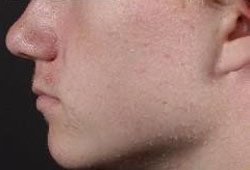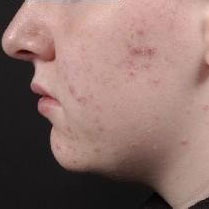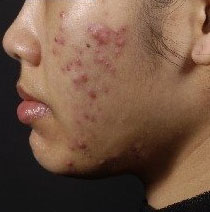History and exam
Key diagnostic factors
common
skin lesions
Open and closed comedones represent the noninflammatory acne lesions; papules, pustules, nodules, and cysts are manifestations of inflammatory lesions.
Postinflammatory hyperpigmentation and scarring may result.[35]
[Figure caption and citation for the preceding image starts]: Comedonal acneUniversity of Michigan Department of Dermatology [Citation ends]. [Figure caption and citation for the preceding image starts]: Typical appearance of acneUniversity of Michigan Department of Dermatology [Citation ends].
[Figure caption and citation for the preceding image starts]: Typical appearance of acneUniversity of Michigan Department of Dermatology [Citation ends]. [Figure caption and citation for the preceding image starts]: Scarring acneUniversity of Michigan Department of Dermatology [Citation ends].
[Figure caption and citation for the preceding image starts]: Scarring acneUniversity of Michigan Department of Dermatology [Citation ends]. [Figure caption and citation for the preceding image starts]: Nodulocystic acneUniversity of Michigan Department of Dermatology [Citation ends].
[Figure caption and citation for the preceding image starts]: Nodulocystic acneUniversity of Michigan Department of Dermatology [Citation ends].
Other diagnostic factors
common
skin tenderness
Inflammatory papules, pustules, cysts, and nodules may be tender to palpation.
uncommon
systemic complaints
Acne fulminans subtype manifests with fever, arthralgias, myalgias, hepatosplenomegaly, and osteolytic bone lesions.
Risk factors
strong
adolescence or young adult
genetic predisposition
A family history of severe acne increases its likelihood in subsequent generations.[19] The concordance rate for the prevalence and severity of acne among identical twins is high.[20] One study concluded that 81% of variance in acne was attributable to genetics, and only 19% to environmental factors.[21] Genome-wide association studies have demonstrated that genetic susceptibility to acne results from a variation in the genes responsible for structure and function of the pilosebaceous unit, which creates an environment prone to bacterial colonization and inflammation, including inherited variation in Toll-like receptors (TLR)-2 and TLR4.[22][23]
oily skin/increased sebum production
Sebaceous follicle size and the number of lobules per gland are increased in people with acne.[14]
Androgens stimulate sebaceous glands to enlarge and produce more sebum, which is most prevalent during puberty.
use of certain drugs
Acneiform eruptions can be caused or exacerbated by some drugs, including androgens, corticosteroids (topical or systemic), anticonvulsants, isoniazid, lithium, Janus kinase inhibitor, and adrenocorticotropic hormone.
use of masculinizing hormone therapy
Acne is one of the most common adverse effects of gender-affirming testosterone therapy, caused, in part, by the overproduction of sebum.[18]
endocrine disorders
People with endocrine disorders such as polycystic ovary syndrome, hyperandrogenism, or precocious puberty are more likely to have severe acne.[10]
female sex
Acne is more prevalent in females than males, one study reported a prevalence rate of 23.6% for females compared with 17.5% in males, and the global burden of disease study 2021 demonstrated that the age-standardized prevalence rate of acne vulgaris was approximately 25% higher in young women than in young men (10,911.8 per 100,000 population vs. 8727.8 per 100,000 population).[9][11] However, there is some evidence to suggest that males tend to have more severe acne.[12][13]
weak
dietary factors
The correlation between dietary factors and acne remains controversial.
Studies provide evidence of a positive association between acne risk and consumption of dairy products such as milk as well as high glycemic index (GI) products (e.g., sugary food and drinks, potatoes, white rice, white bread).[25][26][27][28][29][30] High GI foods and drinks increase levels of insulin and insulin-like growth factor 1, the downstream effects of which include stimulation of androgen synthesis.[10] Despite the apparent links, heterogeneity and bias across studies limits interpretation.[27][31] Further research is needed to be able to draw firm conclusions about the relationship between diet and acne.
obesity/insulin resistance
Insulin and insulin-like growth factor (IGF) can stimulate keratinocytes and sebaceous glands. Elevated IGF-1 levels are found in women with postadolescent acne, and obesity has been found to be associated with an increased prevalence of acne in people aged 20-40 years.[32]
halogenated aromatic hydrocarbons exposure
Occupational or environmental exposures to halogenated aromatic hydrocarbons (e.g., chlorinated dioxins and dibenzofurans) can cause chloracne.[33]
Use of this content is subject to our disclaimer